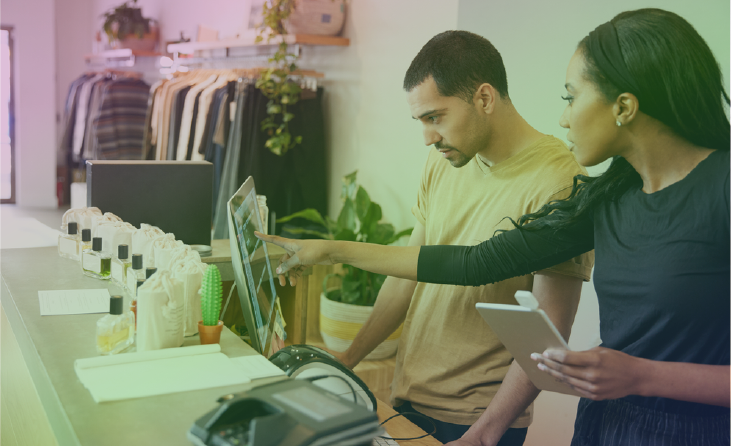
As in-store retail stages a comeback, agile technology will be vital for engaging both customers and staff.
The retail sector’s struggle with COVID-19 is a tale of triumph amid disaster. Despite high-profile insolvencies and almost 190K job losses1, the sector has weathered the storm and emerged more-or-less intact, yet at the same time fundamentally changed.
Retailers have been saved by their capacity to adapt and innovate, with online technology helping them create dynamic, multi-channel experiences with the power to keep customers engaged and loyal.
Technology is the common thread
Now, as retailers re-focus on attracting customers back to stores, technology will be just as pivotal in creating a stand-out experience and in determining who thrives in the new environment.
As a result, the stage is set for an explosion in digital, portable and self-service in-store devices, as epitomised by the Microsoft Surface range. Critically, this needs to be as geared to the needs of frontline staff as it is to the heightened expectations of post-COVID shoppers.
Now more than ever, the in-store experience has a powerful emotional pull
When it works well, online shopping seems magically effortless. Browse some enticing images and thoughtful, well-presented product information, input your payment details and click. A few hours later, the item is placed in your hands.
Despite this, the majority of customers crave a return to physical shopping. According to one survey, 74% say they’ve missed the in-store experience during lockdown.2 In another, 71% were consciously planning a return to a reopened high street.3
The reasons are easy to imagine. For all its convenience, online shopping can only ever be conducted at a distance. Visiting a real shop is tactile, social and direct. It lacks the curated homogeneity of online environments and retains its capacity to excite and surprise. In the aftermath of lockdown, it’s also an exhilarating, life-affirming re-exertion of freedom.
As a result, “soaking up the shopping experience” is a primary motivator for 1 in 4 retail customers, especially younger people.4
This doesn’t automatically mean an easy ride for in-store retailers…
In fact, the reverse is true. Getting your in-store experience right has never been more challenging, and the consequences of failure are stark. Let’s focus on the two key reasons: your customers and your frontline people.
However powerful their yearning to “go shopping”, customers have been profoundly changed by their confinement to online retail. Slick, seamless, multi-channel experiences are now their base expectation, along with flexibility as to how they explore, decide and make their purchase. If they’ve interacted with your brand before, they expect to be recognised and valued in-store, just as they would online – ideally with a personalised discount. The balance of power, in other words, has decisively shifted in their favour.
In-store, the challenge is to marry the best of both worlds: connecting your people instantly to product and stock information, as well as any details you hold about the customer, while maximising the rapport-building power of person-to-person contact.
At the same time, forced exile to e-commerce has made customers appreciate the freedom to self-serve. Small wonder that 87% prefer shopping with retailers that offer intuitive touchless or self-checkout options5, like Microsoft Surface self-serve kiosks and tablets.
How technology nurtures and empowers your people
The competition to attract good staff is just as fierce as for customers. With hiring at its highest level for eight years6, more and more workers seem to be wondering if it’s worth it.
Amid job insecurity, frequent shift changes and unpredictable workloads, it’s small wonder 84% of them reported poor mental health in the last year.6 And as stores reopen, 60% are understandably worried about exposure to COVID-19.7
Again, portable technology like Microsoft Surface can help you restore meaning, reward and flow to your employees’ experience, while facilitating menial tasks, increasing their freedom to be present with customers and enabling them to maintain a safe social distance.
Microsoft Surface: shaping the future of in-store customer service
Microsoft Surface devices are specially adapted for deployment at various points in the retail environment, from warehouse to the frontline. Together with retail-specific software like Dynamics 365 POS and Dynamics 365 Customer Service, as well as next-generation cloud connectivity from Microsoft Azure, you have everything you need to re-engineer your customer and employee experience.
- Portable employee devices allow your people to access key information, process transactions and liaise with colleagues easily, while interacting with customers in a warm, natural and knowledgeable manner that enhances your brand.
- Self-service kiosks enable customers to self-serve for simple requests, while integrating with any online relationship they have with your brand. This facilitates loyalty rewards, personalised suggestions and more.
Microsoft Surface also helps to empower managers, back-office and warehouse teams, enabling you to create a more joined-up and responsive retail operation all round. Find out more.
Sources:
1Almost 190,000 high street jobs axed since first lockdown
2Retail Customer Experience: UK shoppers missing the in-store retail experience
3Footfall begins to recover as shops reopen (brc.org.uk)
4KPMG Annual Retail Survey 2020
5Retail Customer Experience: How physical retailers can attract today’s multichannel shopper
6How can retailers prioritise mental health post-Covid?
760% of UK retail staff worried about Covid-19 exposure